Sculptural wax carving gives you unparalleled creative freedom when designing brooches because you can craft intricate three-dimensional forms and delicate textures that direct metalworking simply can’t achieve. You’ll sculpt organic shapes, geometric patterns, and complex layered elements while making real-time adjustments to refine your design. The compact brooch format becomes your ideal canvas for detailed sculptural work, allowing you to experiment with depths and mixed materials before transforming your vision into durable metal through lost wax casting—unlocking techniques that’ll elevate your artistry to professional levels.
The Ancient Art of Sculptural Wax Carving and Its Modern Applications
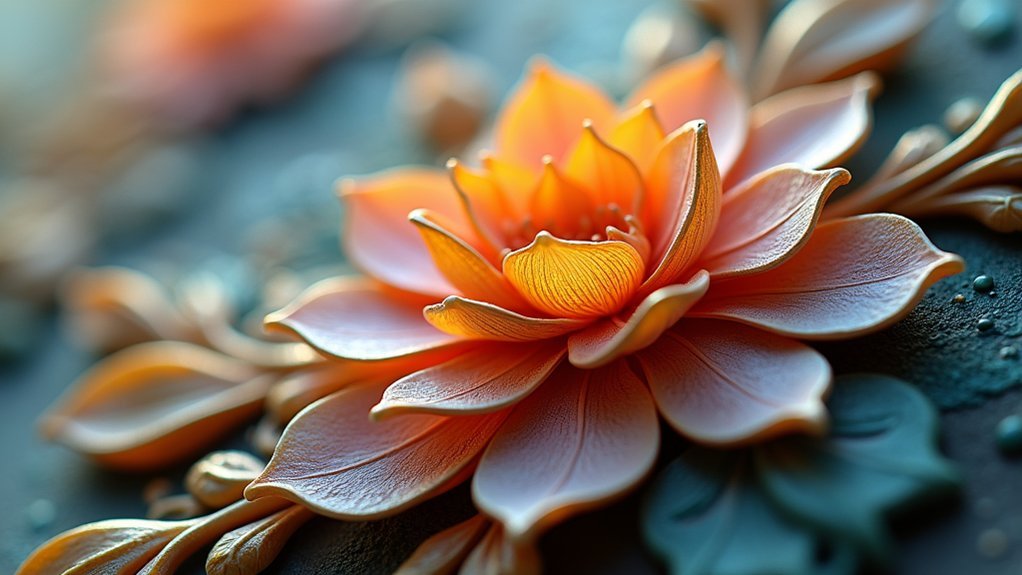
While ancient civilizations first developed sculptural wax carving over 6,000 years ago, today’s artisans have transformed this time-honored technique into a sophisticated method for creating extraordinary brooches.
You’ll find that traditional wax carving methods remain at the heart of this craft, where skilled hands shape intricate details using specialized tools and techniques passed down through generations.
Modern jewellery making has enhanced these ancient foundations with innovative technologies like CAD design, allowing you to achieve unprecedented precision in your brooch creations.
The lost wax casting process guarantees every carved detail transfers flawlessly from wax to metal, preserving your artistic vision.
Whether you’re using hand-carving methods or incorporating digital tools, you’re participating in a craft that seamlessly bridges millennia of artistic tradition with contemporary innovation.
Why Brooches Are Perfect Canvas for Wax Carving Techniques
Because brooches offer a concentrated design space, they’re perfectly suited to showcase the intricate sculptural qualities that make wax carving so compelling.
You’ll find that this compact canvas allows for remarkably detailed textures and complex three-dimensional elements that would be challenging to achieve in larger pieces.
When you work with wax carving for brooches, you can create both figurative and abstract designs that reflect your personal style.
The medium’s versatility lets you incorporate multiple layers and depths, producing unique visual effects that transform flat surfaces into dynamic sculptures.
The lost wax casting process guarantees every carved detail transfers perfectly to the final piece.
You can even integrate mixed materials like stones or metals, enhancing the artistic value and making each brooch a distinctive wearable sculpture.
Creative Freedom and Three-Dimensional Design Possibilities
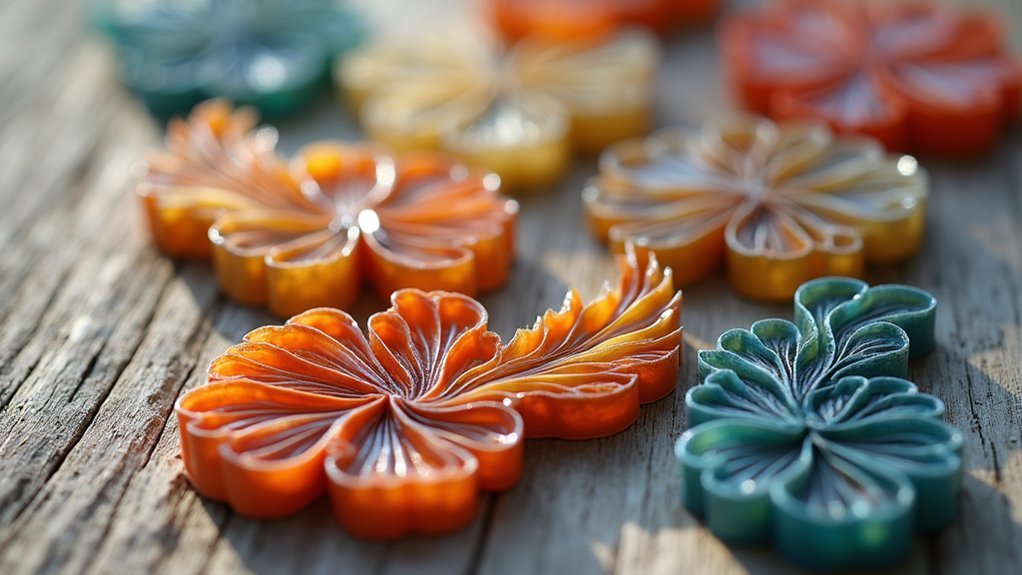
This concentrated design space opens up extraordinary creative possibilities that extend far beyond traditional jewelry-making constraints.
You’ll discover that sculptural wax carving grants you unprecedented creative freedom to experiment with forms that metalworking simply can’t achieve directly. Using specialized wax carving tools, you can sculpt flowing organic shapes, intricate geometric patterns, and complex undercuts that would be impossible through conventional methods.
Sculptural wax carving unleashes unprecedented creative freedom, enabling forms and intricate details impossible through conventional metalworking methods.
The three-dimensional design potential becomes limitless when you’re working with malleable wax. You can build up layers, hollow out sections, and create delicate filigree work with remarkable precision.
Each adjustment happens in real-time, allowing you to refine your vision instantly. Through lost wax casting, every texture and detail you’ve carved transfers perfectly to the final metal piece, preserving your artistic expression completely.
Achieving Intricate Details and Textures Through Hand Carving
You’ll master intricate brooch details by developing precise tool control that lets you carve fine lines and delicate features with confidence.
Building textures requires a layered approach where you’ll scrape, carve, and shape the wax in multiple passes to create complex surface patterns.
Your finishing techniques will determine the final quality, as you’ll refine each detail until it meets your artistic vision before casting.
Precise Tool Control Techniques
Three fundamental aspects define precise tool control in wax carving: grip stability, pressure modulation, and directional consistency. You’ll develop exceptional wax carving skills by maintaining a controlled grip that prevents unwanted movements while sculpting wax.
Your pressure application must vary deliberately—light touches for delicate surface textures, firmer pressure for removing larger sections. Directional consistency guarantees smooth, intentional cuts that create intricate details without compromising your brooch’s structural integrity.
You’ll need specialized tools like wax files, detailers, and scalpel blades to achieve different effects. Practice moving tools in steady, controlled motions rather than rushed strokes.
This precise tool control allows you to manipulate every contour accurately, preserving intended proportions and symmetry. Regular experimentation with various tool angles and pressure combinations will refine your technique, enabling increasingly sophisticated detail work.
Layered Texture Building Methods
- Scraping techniques – Remove material to create recessed patterns and smooth shifts between texture zones.
- Additive layering – Build up areas with soft pink wax for easy shaping, then add hard green wax for fine details.
- Heat pen refinement – Blend textures seamlessly while preserving intricate details for the casting process.
This experimental approach lets you create personalized designs that reflect your artistic vision while ensuring every textural detail transfers perfectly to your final brooch.
Fine Detail Finishing
While your textural foundation provides the brooch’s character, fine detail finishing transforms your wax carving into a masterpiece worthy of precious metal.
You’ll achieve this precision using specialized tools for wax like dental instruments and scalpel blades, which allow you to carve intricate lines and delicate surface textures that softer tools can’t accomplish.
Your wax choice directly impacts fine detail quality. Green wax’s hardness maintains sharp edges and crisp details throughout the carving process.
Once you’ve completed your intricate work, you must guarantee your piece is polished and finished using files and sandpaper. This smoothing process preserves every carefully carved detail during casting, preventing imperfections from transferring to your final metal brooch and maintaining the sophisticated craftsmanship that distinguishes hand-carved pieces.
The Lost Wax Casting Process for Brooch Creation
Although traditional metalworking techniques can produce beautiful brooches, the lost wax casting process opens up a world of intricate possibilities that you simply can’t achieve through conventional hammering or filing.
This ancient technique transforms your detailed wax model into stunning metal jewelry pieces through a precise multi-step process.
Here’s how lost wax casting creates exceptional brooches:
- Sculpt your wax model – Carve intricate designs and textures that capture every artistic detail you envision.
- Create the mold – Build a casting form around your wax, then melt out the wax to leave a perfect cavity.
- Pour molten metal – Fill the cavity with silver or bronze, creating an exact replica of your original design.
Once cooled, you’ll break away the mold to reveal your finished brooch, ready for final polishing.
Tools and Materials Essential for Sculptural Wax Work
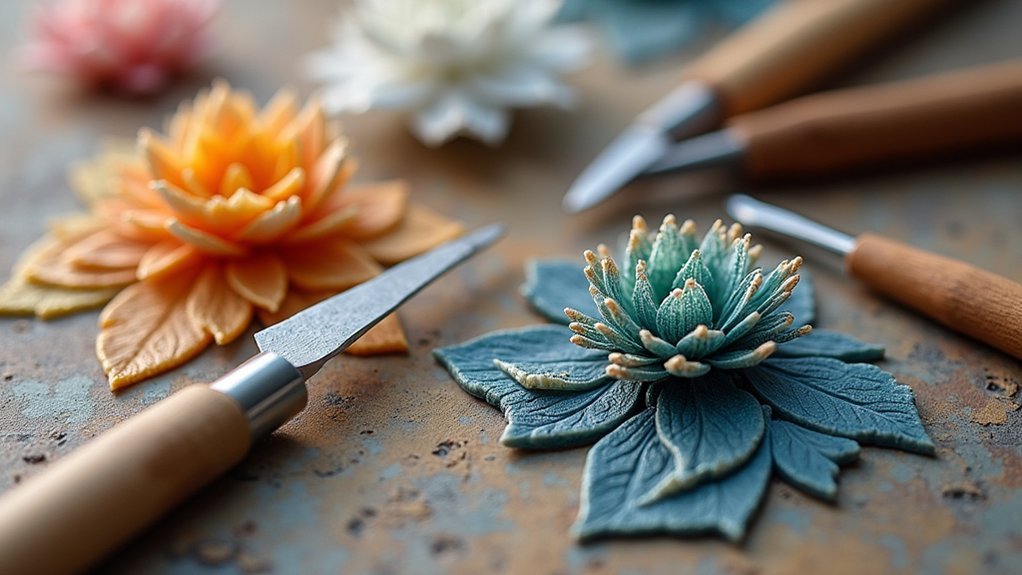
Before you can transform your artistic vision into a perfectly cast brooch, you’ll need the right tools and materials to shape your wax model with precision.
Essential carving tools include wax saw blades for cutting blocks and professional wax files for shaping intricate details. You’ll want a heat pen for quick repairs and fine work, plus spirit lamps or electric wax carvers for controlled heating during detailed sessions.
Precision wax carving demands quality tools: sharp saw blades, professional files, reliable heat pens, and controlled heating sources for detailed work.
Your material choices matter greatly. Green wax works excellently for intricate designs, while Gold Wolf Wax™ handles 3D milling beautifully.
Don’t forget wax wire for decorative elements and various block sizes for different piece scales. A polishing wheel guarantees your finished model has that smooth, professional appearance, and safety glasses protect you throughout the entire carving process.
From Concept to Wearable Art: The Complete Design Journey
Creative inspiration strikes differently for every artist, but transforming that initial spark into a finished brooch requires a systematic approach that balances artistic vision with technical precision.
Your design journey begins with detailed sketches, mapping out every dimension and texture before touching the wax. You’ll select the appropriate wax type—blue for intricate details or green for sharp precision—then hand-carve your model with complete creative control.
The transformation from concept to wearable art follows three critical phases:
- Sculpting: Hand-carve your wax model, creating unique textures and forms
- Casting: Use lost wax casting technique to transform wax into durable metal
- Finishing: Polish and set stones to elevate your piece of jewelry
Through wax carving, you’ll create bespoke brooches that tell stories while preserving every intricate detail you’ve carefully crafted.
Mastering Advanced Techniques for Professional Brooch Making
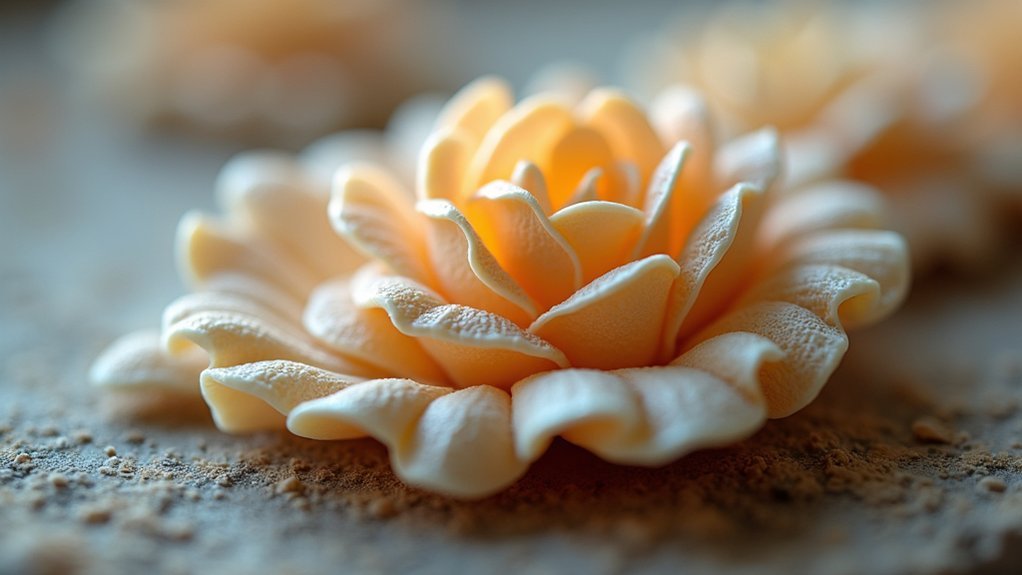
You’ll elevate your brooch work by mastering complex dimensional relief techniques that transform flat surfaces into sculptural masterpieces with varying depths and intricate textures.
These advanced methods require precise control of your carving tools to create seamless shifts between raised and recessed areas that catch light beautifully.
Professional finishing methods then guarantee your pieces meet industry standards, giving you the polished results that distinguish amateur work from gallery-worthy creations.
Complex Dimensional Relief Techniques
Although sculptural wax carving requires patience and skill, mastering complex dimensional relief techniques transforms ordinary brooch designs into enthralling three-dimensional artworks that command attention.
When you understand 3D forms, you’ll manipulate wax to capture light and shadows effectively, creating depth that flat designs can’t achieve.
Wax carving involves strategic layering methods that build intricate patterns:
- Experimentation with wax types – Use hard green wax for fine details and soft pink wax for larger sculptural elements
- Precision tools application – Deploy wax detailers and modeller scalpels for professional refinement
- Multiple element integration – Combine various textures and depths into cohesive designs
Each piece sculpted by hand becomes unique, as these techniques allow you to create varying textures that enhance visual appeal while maintaining structural integrity.
Professional Finishing Methods
When you shift from carving to finishing, professional finishing methods separate amateur work from museum-quality pieces that captivate collectors.
You’ll master polishing techniques using fine sandpaper and compounds to achieve mirror-like surfaces that showcase your craftsmanship. As a skilled wax carver, you’ll employ engraving and texturing tools to add intricate details that transform ordinary brooches into extraordinary art pieces.
Your heat pen becomes essential for precise edge refinement and seamless changes between design elements.
After casting into precious metals, you’ll apply patination or plating to enhance visual appeal and durability.
Complete your finishing process with soft brushes and ultrasonic cleaners to eliminate residual wax, ensuring a pristine surface worthy of professional presentation.
Frequently Asked Questions
What Does Sculpting Wax Do?
You’ll shape sculpting wax into detailed designs that can’t be achieved through traditional metalworking. It’s flexible, allowing corrections and experimentation while preserving intricate textures through the lost wax casting process.
What Is Wax Carving in Jewelry?
You’ll sculpt wax into jewelry designs before casting them in metal. This technique lets you create intricate details that’d be difficult with traditional metalworking, giving you unlimited creative freedom for personalized pieces.
What Was the Wax Technique of Making Statues Explain?
You’d create a detailed wax model by hand, then build a mold around it. Once you’ve melted the wax away, you’ll pour molten metal into the cavity, preserving every intricate detail.
What Is the Difference Between Green and Blue Carving Wax?
You’ll find green carving wax is harder and better for intricate details, while blue wax is more flexible, making it easier to shape and perfect for thin walls or larger pieces.
In Summary
You’ll discover that sculptural wax carving transforms brooch making into pure artistic expression. You’re not just creating jewelry—you’re sculpting miniature masterpieces with unlimited design freedom. The lost wax process lets you capture every intricate detail you’ve carved by hand, from flowing textures to complex three-dimensional forms. When you master these techniques, you’ll turn simple concepts into wearable art that’s impossible to achieve through traditional metalworking methods alone.

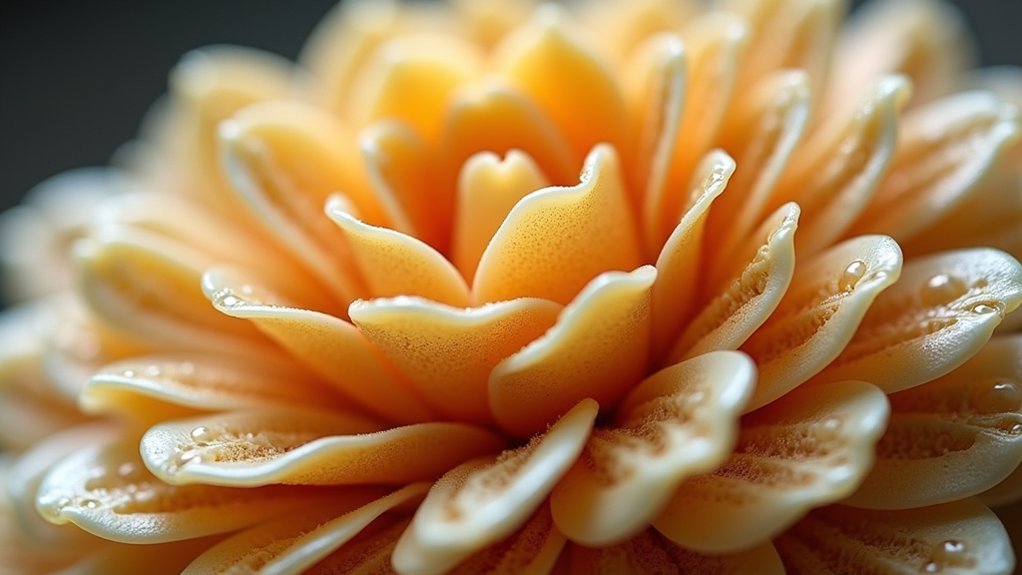



Leave a Reply